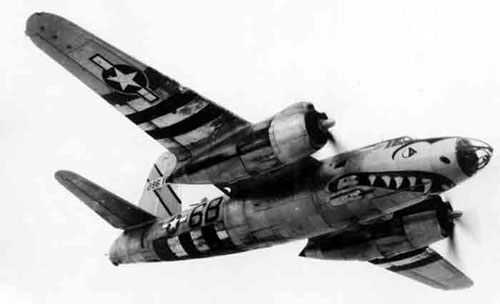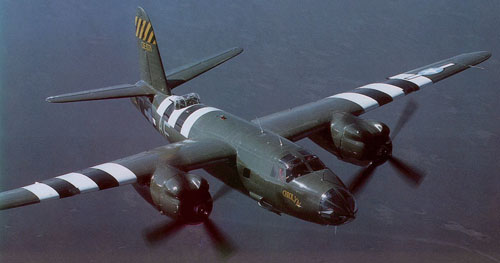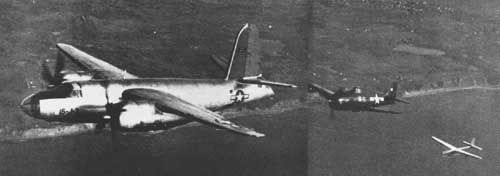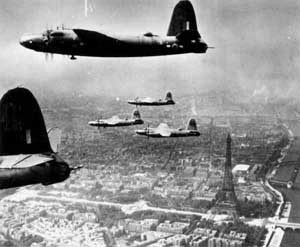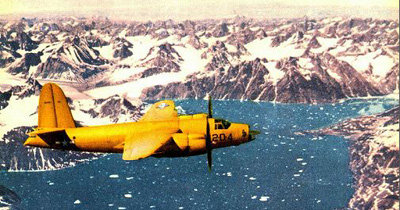| |
|
|
|
|
| |
back to Marauder main |
 |
| Martin Marauder |
The Martin Marauder goes back to a request of the U.S. Army Air Corps for a fast medium bomber, made in 1939, still before world war two broke out in Europe. The B-26 was meant to replace the obsolete B-10 and B-18. The design of Glenn L. Martin Company was ordered straight off the drawing board and not even a prototype flew before.
The first aircraft to be produced became the quasi-prototype and made it’s maiden flight on November 25th, 1940. The first B-26’s were delivered to operational squadrons in 1941, after having been tested at the the airbase Patterson Field, today the site of the U.S. Air Force museum.
The Marauder showed a much better performance than its contemporary, the B-25 Mitchell, but it’s wings were comparably small and it had the heaviest weight to wing surface ratio until then. This led to a very long take-off distance amd required fast landing speeds, because the wing would have a stall in too slow speeds, leading to a crash. Another problem were chronic breakdowns of the front landing gear strut, due to bad weight distribution. This again was a result of the new turbo turrets not being installed yet.
The worst problem were those of the propellers and of of sudden loss of power on the engines, especially during take-off. These problems led to numerous crashes, which made the B-26 a feared type among flight students. It led to various nicknames for the B-26 such as “Martin Murderer”, “Widowmaker”, “Flying coffin”, but also “Flying Prostitute”, because the wings were so small and the plane had “no visible means of support”. Since the flight trainign was held in Tampa Bay, Florida, it also led to the phrase “A Marauder a day in Tampa Bay”

|
|
Modifications on the airframe and improved flight training let the B-26 pilots to be better able to control the plane and less accidents occured. But it was still considered impossible to fly a B-26 with only one engine. This was however disproved by a number of experienced pilots, most notably Jimmy Doolittle.
Even though B-26’s were deployed mostly in Europe, their first mission took place in the south pacific, conducting an attack on a japanese base on Rabaul from an australian base. Four Marauders were also used as torpedo-bombers during the battle of Midway.
Even though the missions in the pacific had been successful, the MArauders were withdrwan there and replaced by the older B-25 Mitchells, becuase they were more suited for the island-war thanks to their long range and short take-off distance. The first mission of a B-26 in Europe was flown on May 14th 1943, and the second one became a disaster, as ten aircraft were lost from flak-fire and midair collisions. The tactics were modified after that, and low-level attacks were given up in favour of level-bombing: The new average height for the bomb drops was 10000?15000ft (3048?4573m) This supposedly helped to
let the Marauder have the lowest loss rate of all allied planes later on. The Marauder first proved its usefulness during the invasion of normandy, providing tactical support to the advancing troops. Later on, the Marauder became the main target of the first german jetfighter, the Me-262.
 |
| The three main paint schemes can be seen in formation here: Olive, half-silver-half-olive and silver |
 |
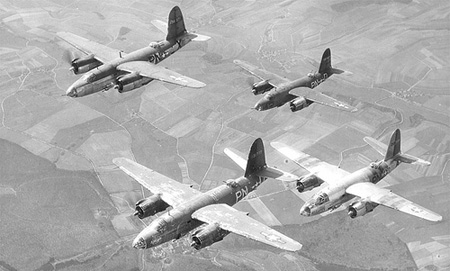
|
| |
|
The Royal Air Force also had a lot of problems with the Marauder at the beginning, using it in North africa and the middle east. The Marauder was replacing Bristol Blenheims, which required a huge adaption by the crews, because while the Blenheim was easy to fly, but highly vulnerable, the Marauder could sustain a lot of damage, but was unforgiving with flying mistakes. The Royal Air Force used the Marauder quite succesfully as a torpedo bomber and Naval Reconnaisance, as well as a interceptor for german transport aircraft crossing the mediterranean.
 |
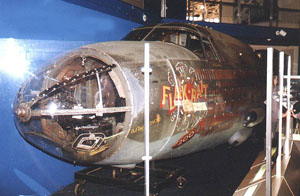 |
The Front section of the
"Flak-bait", the most succesful B-26 of World war 2. |
|
 |
The U.S. Navy used a number of Marauders under the designation JM-1. These machines were stripped of all unrequired equipment, such as turret, machine guns, bomb racks and navigational equipment to make them as light as possible for their new role as target tugs. The targets were pulled by a steel line and fired upon with paintball munition by Navy fighters.
 |
|
Altogether, over 110000 missions have been flown with the B-26. When the war ended in Europe after the german capitulation, most B-26’s were decomissioned and scrapped. The designation of B-26 was passed on to the Douglas A-26 Invader, which was used until long after the Korea war. Only few of the 5266 Marauders build survive until today, and there is only one airworthy Marauder on earth. The most famous Marauder is undoubtedlty the “Flak bait”, which turned out the single aircraft with the most missions flown in world war two. Its forward fuselage section is displayed in the National Air and Space museum in Washington, DC today.
 |
|
| |
|
| |
wingspan: 21.65m
length: 17.8m
height: 6.55m
empty weight: 11.000kg
max loaded weight: 17.000kg
maximum speed: 460km/h
range: 1850km |
| |
| return to top |
|
|
|

